Critical Hazards Identification and Prevention of Cascading Escalator Accidents at Metro Rail Transit Stations
Abstract
1. Introduction
2. Literature Review
3. Methods
3.1. Cascading Escalator Accidents Investigation Methods
3.2. Network Modelling Methods
3.3. Network Analysis Methods
3.3.1. Degree and Strength of Hazards
3.3.2. The CC of Hazards
3.3.3. The Betweenness of Hazards
4. Case Study
4.1. Beijing Cascading Escalator Accidents Data Gathering
4.2. Beijing CEHN Modelling and Visualization
4.3. Analyzing the Topological Characteristics of Beijing CEHN
4.3.1. Degree and Strength Distribution
4.3.2. Un-Weighted and Weighted CC of Hazards
4.3.3. Betweenness Centrality
5. Discussion
6. Conclusions
Author Contributions
Funding
Conflicts of Interest
Appendix A
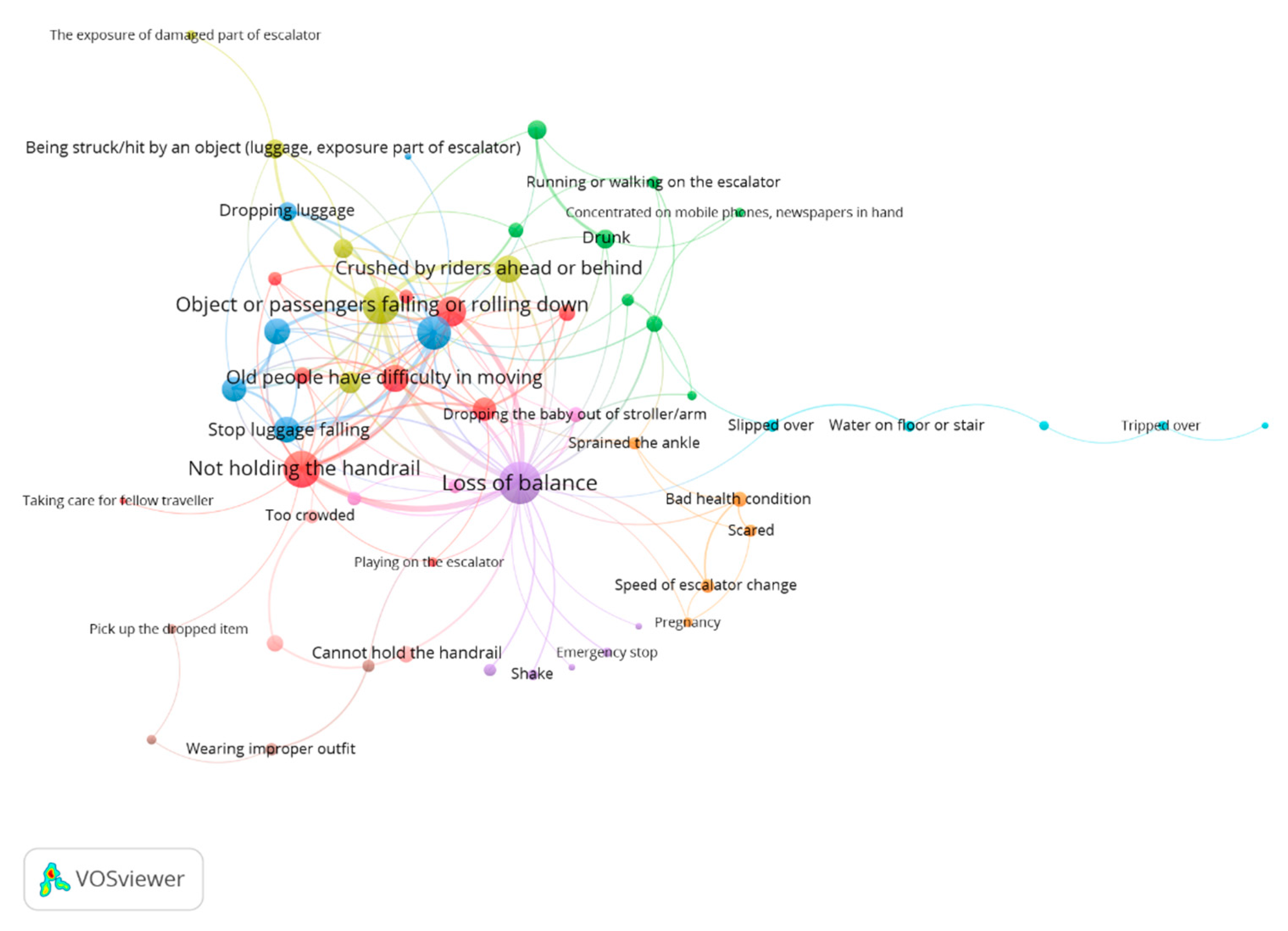
References
- Chi, C.-F.; Chang, T.-C.; Tsou, C.-L. In-depth investigation of escalator riding accidents in heavy capacity MRT stations. Accid. Anal. Prev. 2006, 38, 662–670. [Google Scholar] [CrossRef] [PubMed]
- Xie, K.; Liu, Z. Factors influencing escalator-related accidents in China: A systematic analysis using ISM-DEMATEL method. Int. J. Environ. Res. Public Health 2019, 16, 2478. [Google Scholar] [CrossRef] [PubMed]
- The Government of the Hong Kong Special Administrative Region. Number of the Passenger involved Accident on MRT Station in Hong Kong in the Last Five Years. 2013. Available online: https://www.emsd.gov.hk/tc/lifts_and_escalators_safety/publications/contractors_performance_rating/reported_escalator_incident_records/index.html (accessed on 12 May 2020).
- Xing, Y.; Dissanayake, S.; Lu, J.; Long, S.; Lou, Y. An analysis of escalator-related injuries in metro stations in China, 2013–2015. Accid. Anal. Prev. 2019, 122, 332–341. [Google Scholar] [CrossRef] [PubMed]
- Pescaroli, G. Perceptions of cascading risk and interconnected failures in emergency planning: Implications for operational resilience and policy making. Int. J. Disaster Risk Reduct. 2018, 30, 269–280. [Google Scholar] [CrossRef]
- Basir, F.A.M.; Yaziz, A.H.; Zamri, M.H.; Halim, A.H.A.; Noordin, F.; Bin Othman, A.K.; Kassim, E.S. Escalator Accidents: Causes and Users’ Behavior Empirical Study of Kuala Lumpur Users. In Proceedings of the 2nd Advances in Business Research International Conference; Springer: Singapore, 2017; pp. 289–296. [Google Scholar]
- Gill, J.C.; Malamud, B. Reviewing and visualizing the interactions of natural hazards. Rev. Geophys. 2014, 52, 680–722. [Google Scholar] [CrossRef]
- Buzna, L.; Peters, K.; Helbing, D. Modelling the dynamics of disaster spreading in networks. Phys. A: Stat. Mech. its Appl. 2006, 363, 132–140. [Google Scholar] [CrossRef]
- McGeehan, J.; Shields, B.J.; Wilkins, J.; Ferketich, A.K.; Smith, G.A. Escalator-Related Injuries Among Children in the United States, 1990-2002. Pediatrics 2006, 118, e279–e285. [Google Scholar] [CrossRef]
- Dhanasekaran, R.; Vinothkanna, R.; Sreenatha, R.S.; Narendra, K.M.; Bala, K.P. A Review of Escalator Accidents and Preclusion. GRD J. Eng. 2016, 1, 132–136. [Google Scholar]
- Platt, S.L.; Fine, J.S.; Foltin, G.L. Escalator-related injuries in children. Pediatrics 1997, 100, e2. [Google Scholar] [CrossRef]
- Shiwakoti, N.; Tay, R.; Stasinopoulos, P.; Woolley, P.J. Likely behaviours of passengers under emergency evacuation in train station. Saf. Sci. 2017, 91, 40–48. [Google Scholar] [CrossRef]
- O’Neil, J.; Steele, G.K.; Huisingh, C.; Smith, G.A. Escalator-related injuries among older adults in the United States, 1991–2005. Accid. Anal. Prev. 2008, 40, 527–533. [Google Scholar] [CrossRef] [PubMed]
- Lee, D.H.; Kim, C.; Kim, S.; Lee, S. An Analysis of Escalator-Related Injuries in an Emergency Department. Hong Kong J. Emerg. Med. 2010, 17, 212–217. [Google Scholar] [CrossRef]
- Schminke, L.H.; Jeger, V.; Evangelopoulos, D.S.; Zimmerman, H.; Exadaktylos, A.K. Riding the Escalator: How Dangerous is it Really? West. J. Emerg. Med. 2013, 14, 141–145. [Google Scholar] [CrossRef] [PubMed]
- Drury, C.G.; Brill, M. Human Factors in Consumer Product Accident Investigation. Hum. Factors: J. Hum. Factors Ergon. Soc. 1983, 25, 329–342. [Google Scholar] [CrossRef] [PubMed]
- Li, W.; Gong, J.; Yu, P.; Shen, S. Modeling, simulation and analysis of group trampling risks during escalator transfers. Phys. A: Stat. Mech. Appl. 2016, 444, 970–984. [Google Scholar] [CrossRef]
- Li, W.; Gong, J.; Yu, P.; Shen, S.; Li, R.; Duan, Q. Simulation and analysis of individual trampling risk during escalator transfers. Phys. A: Stat. Mech. Appl. 2014, 408, 119–133. [Google Scholar] [CrossRef]
- Kauffmann, P.; Kikuchi, S. Modeling the Practical Capacity of Escalators A Behavioral Approach to Pedestrian Simulation. Transp. Res. Rec. 2013, 2350, 136–142. [Google Scholar] [CrossRef]
- Heinrich, H.W. Industrial Accident Prevention: A Scientific Approach; McGraw-Hill: New York, NY, USA, 1941. [Google Scholar]
- Zhang, J.; Zhang, W.; Xu, P.; Chen, N.; Peixui, X. Applicability of accident analysis methods to Chinese construction accidents. J. Saf. Res. 2019, 68, 187–196. [Google Scholar] [CrossRef]
- Ren, J.; Jenkinson, I.; Wang, J.; Xu, D.L.; Yang, J.B. A methodology to model causal relationships on offshore safety assessment focusing on human and organizational factors. J. Saf. Res. 2008, 39, 87–100. [Google Scholar] [CrossRef]
- Al-Sharif, L. Escalator Human Factors: Passenger Behaviour, Accidents and Design. 2006. Available online: https://www.researchgate.net/publication/278027725_Escalator_Human_Factors_Passenger_Behaviour_Accidents_and_Design (accessed on 12 May 2020).
- Li, Q.; Song, L.; List, G.F.; Deng, Y.; Zhou, Z.; Liu, P. A new approach to understand metro operation safety by exploring metro operation hazard network (MOHN). Saf. Sci. 2017, 93, 50–61. [Google Scholar] [CrossRef]
- Zhou, Z.; Irizarry, J.; Li, Q. Using network theory to explore the complexity of subway construction accident network (SCAN) for promoting safety management. Saf. Sci. 2014, 64, 127–136. [Google Scholar] [CrossRef]
- Deng, Y.; Li, Q.; Lu, Y. A research on subway physical vulnerability based on network theory and FMECA. Saf. Sci. 2015, 80, 127–134. [Google Scholar] [CrossRef]
- Von Ferber, C.J.; Holovatch, T.; Holovatch, Y.; Palchykov, V. Public transport networks: Empirical analysis and modeling. Eur. Phys. J. B 2009, 68, 261–275. [Google Scholar] [CrossRef]
- Ersozlu, Z.; Karakus, M.; Ersozlu, Z. Mathematics Anxiety: Mapping the Literature by Bibliometric Analysis. Eurasia J. Math. Sci. Technol. Educ. 2019, 15, 2. [Google Scholar] [CrossRef]
- Van Eck, N.J.; Waltman, L. Citation-based clustering of publications using CitNetExplorer and VOSviewer. Scientometrics 2017, 111, 1053–1070. [Google Scholar] [CrossRef]
- Wang, Z. Subway Netowrk Model Construciton Method. China Patent CN108897920-A, 2018. Available online: https://n.ustb.edu.cn/http/77726476706e69737468656265737421f4f55189257e6b5e7501c7a29d41/grid2008/dbpub/detail.aspx?dbcode=SCPD&dbname=SCPD2019&filename=CN108897920A&uid=WEEvREcwSlJHSldRa1FhcEFLUmViU1hKSWF2VDgveU1mM2tIbmZiTkx2QT0=$9A4hF_YAuvQ5obgVAqNKPCYcEjKensW4IQMovwHtwkF4VYPoHbKxJw (accessed on 12 May 2020).
- Wandelt, S.; Sun, X. Evolution of the international air transportation country network from 2002 to 2013. Transp. Res. Part E: Logist. Transp. Rev. 2015, 82, 55–78. [Google Scholar] [CrossRef]
- Wang, Z.; Niu, F.; Yang, L.; Su, G. Modeling a subway network: A hot-point attraction-driven evolution mechanism. Phys. A: Stat. Mech. Appl. 2020, 537, 122625. [Google Scholar] [CrossRef]
- Wang, Z.; Su, G.; Liang, Z. Information transfer efficiency based small-world assessment methodology for metro networks. J. Tsinghua Univ. Sci. Technol. 2016, 56, 411–416. [Google Scholar]
- Albert, R.; Barabási, A.-L. Statistical mechanics of complex networks. Rev. Mod. Phys. 2002, 74, 47–97. [Google Scholar] [CrossRef]
- Fruin, J.J. Pedestrian Planning and Design; Metropolitan Association of Urban Designers and Environmental Planners: New York, NY, USA, 1971. [Google Scholar]
- Devis, P.; Dutta, G. Estimating of Capacity of Escalators in London Underground. Iima Working Pap. 2002. [Google Scholar]
- Hong Kong Metro Rail Transit, Traval Safety Every Day in Hong Kong MTR-Escalator Riding Instruction. Available online: https://www.mtr.com.hk/archive/corporate/en/press_release/PR-17-072-C.pdf (accessed on 25 August 2017).
- Kauffmann, P.D. Traffic Flow on Escalators and Moving Walkways: Quantifying and Modeling Pedestrian Behavior in a Continuously Moving System. Ph.D. Thesis, Virginia Tech, Blacksburg, VA, USA, 2011. [Google Scholar]

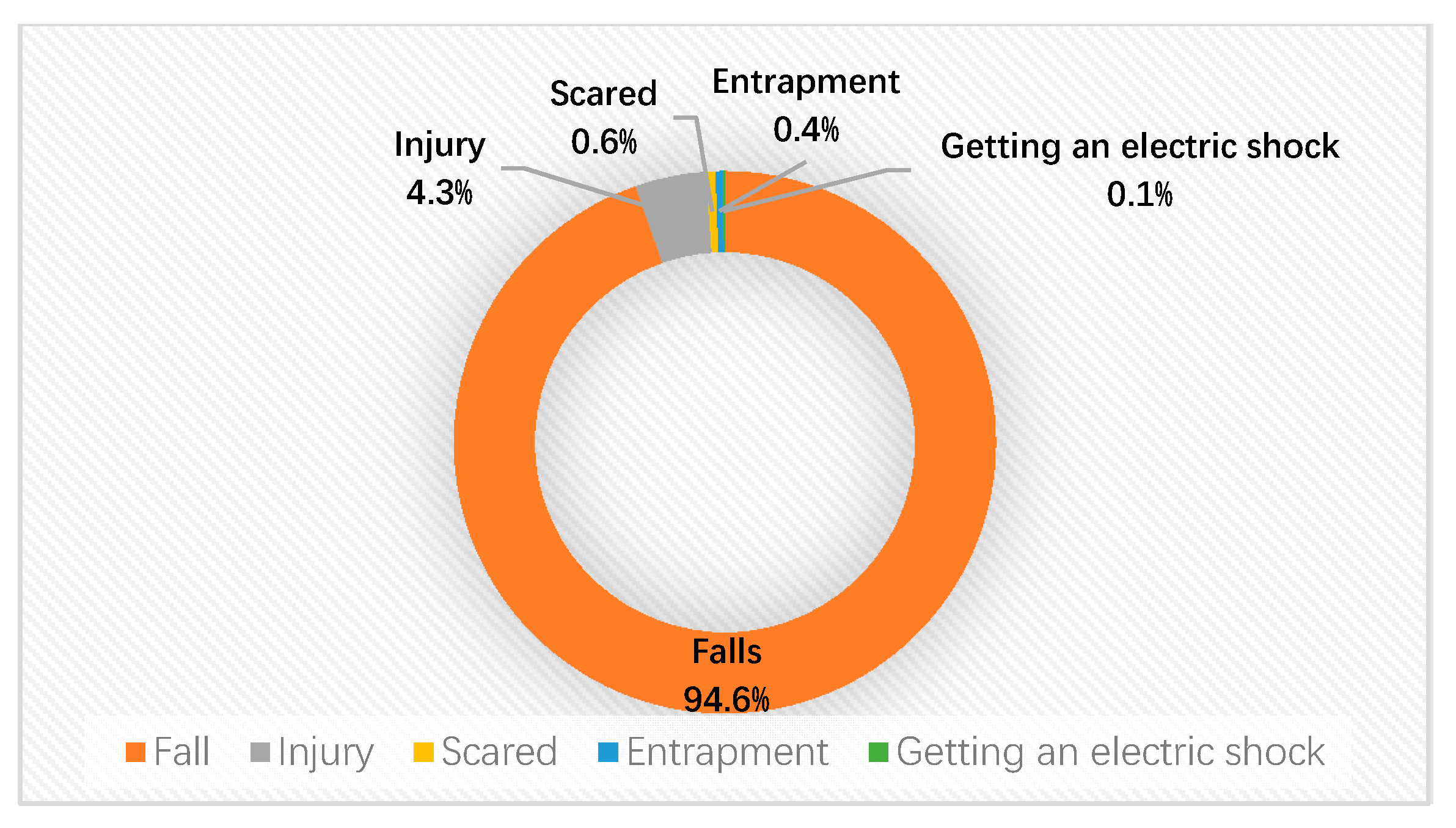
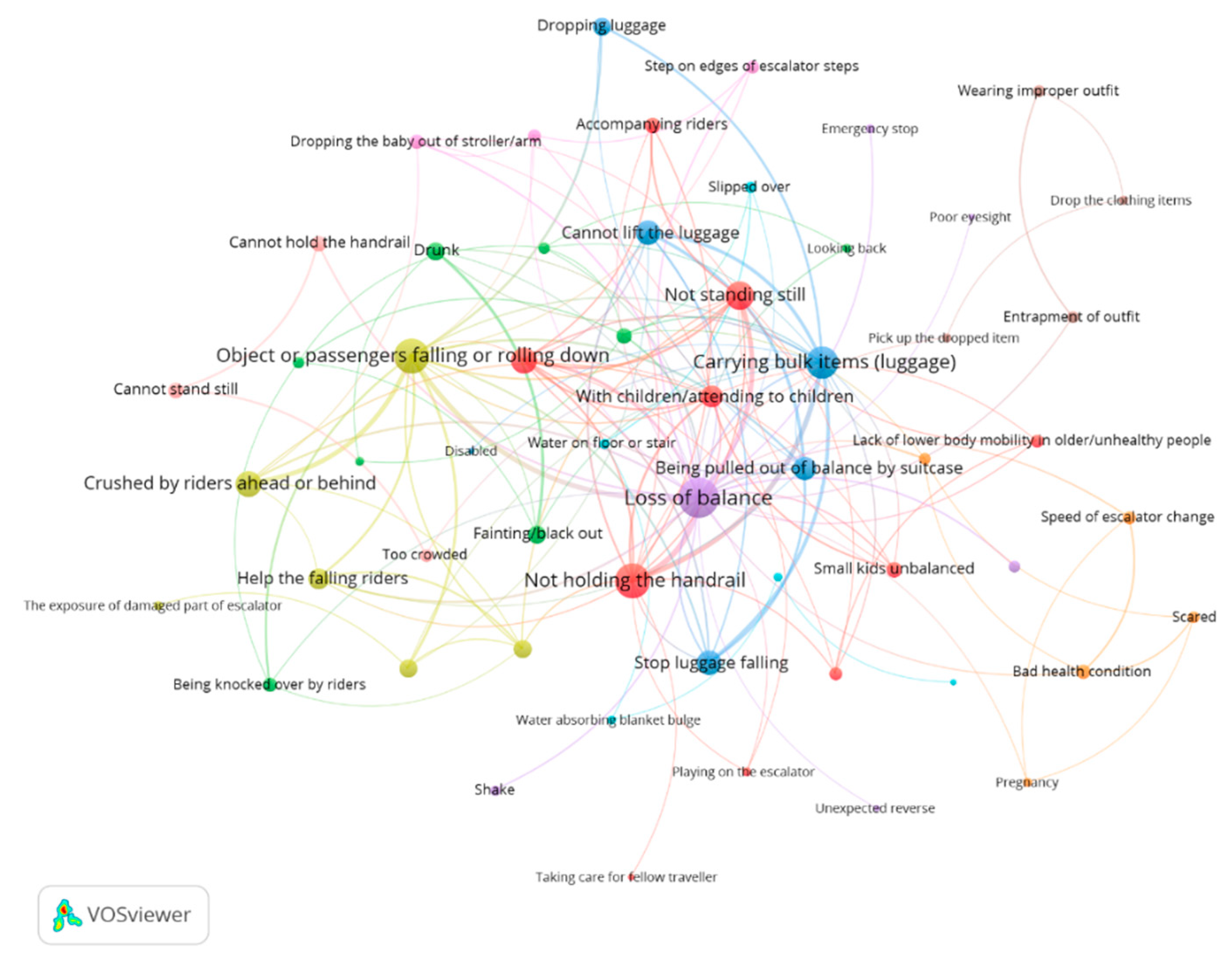
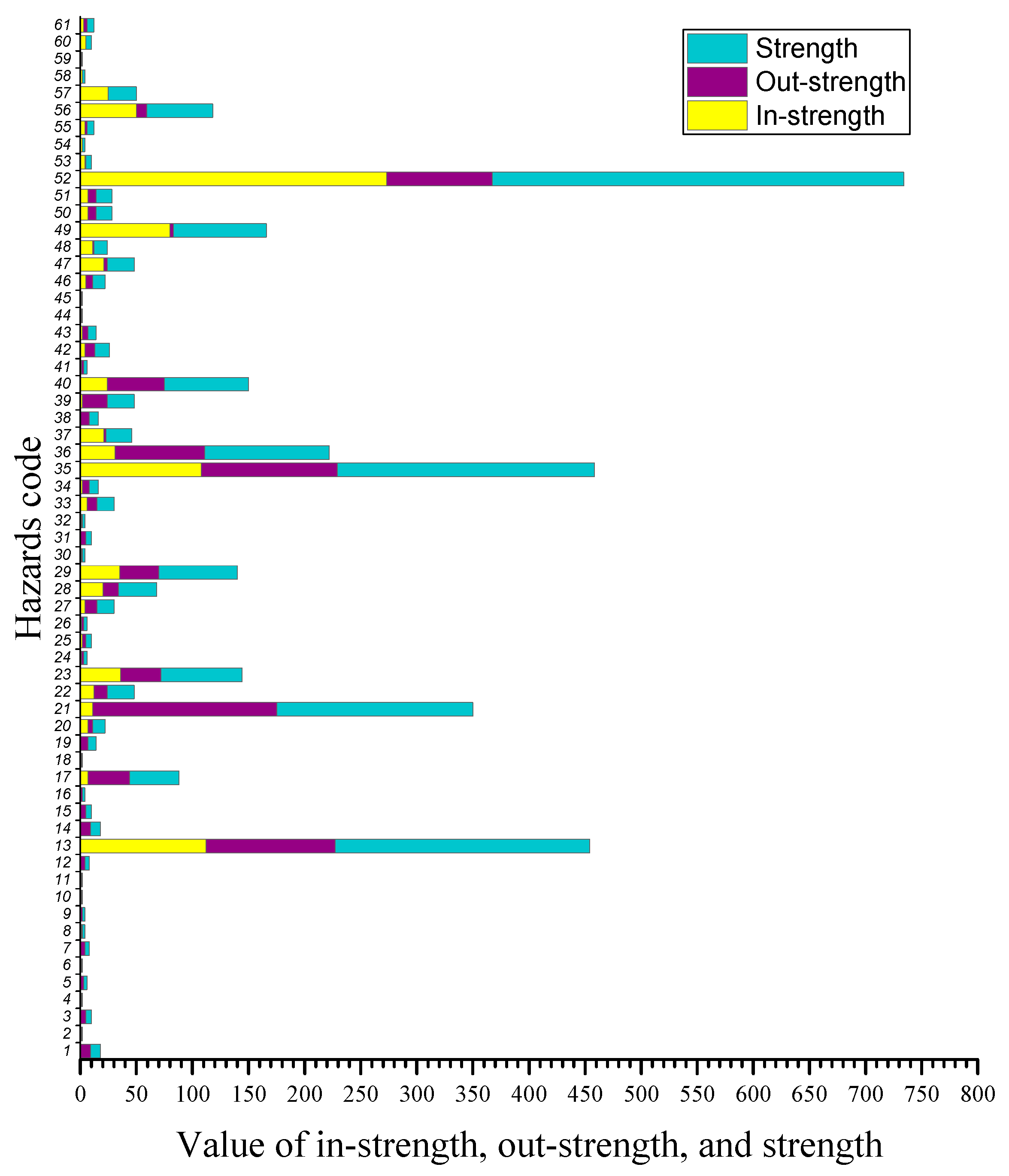

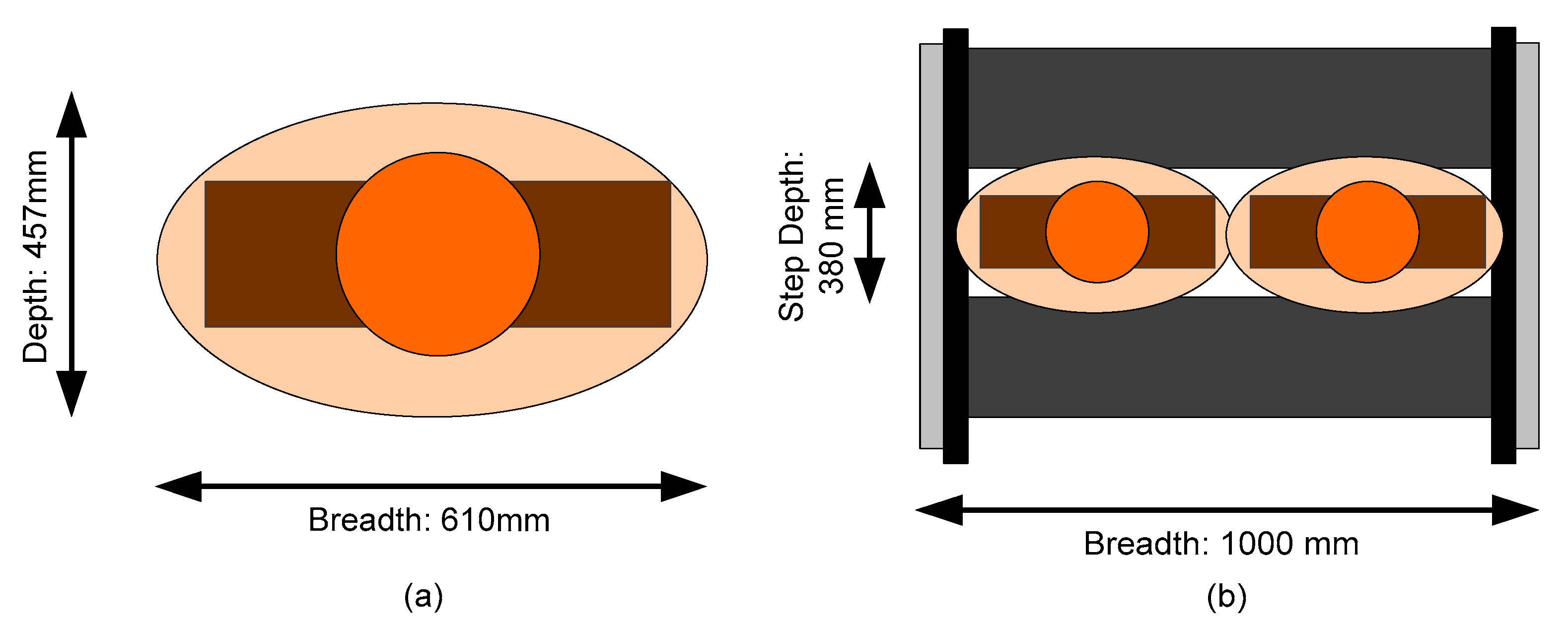
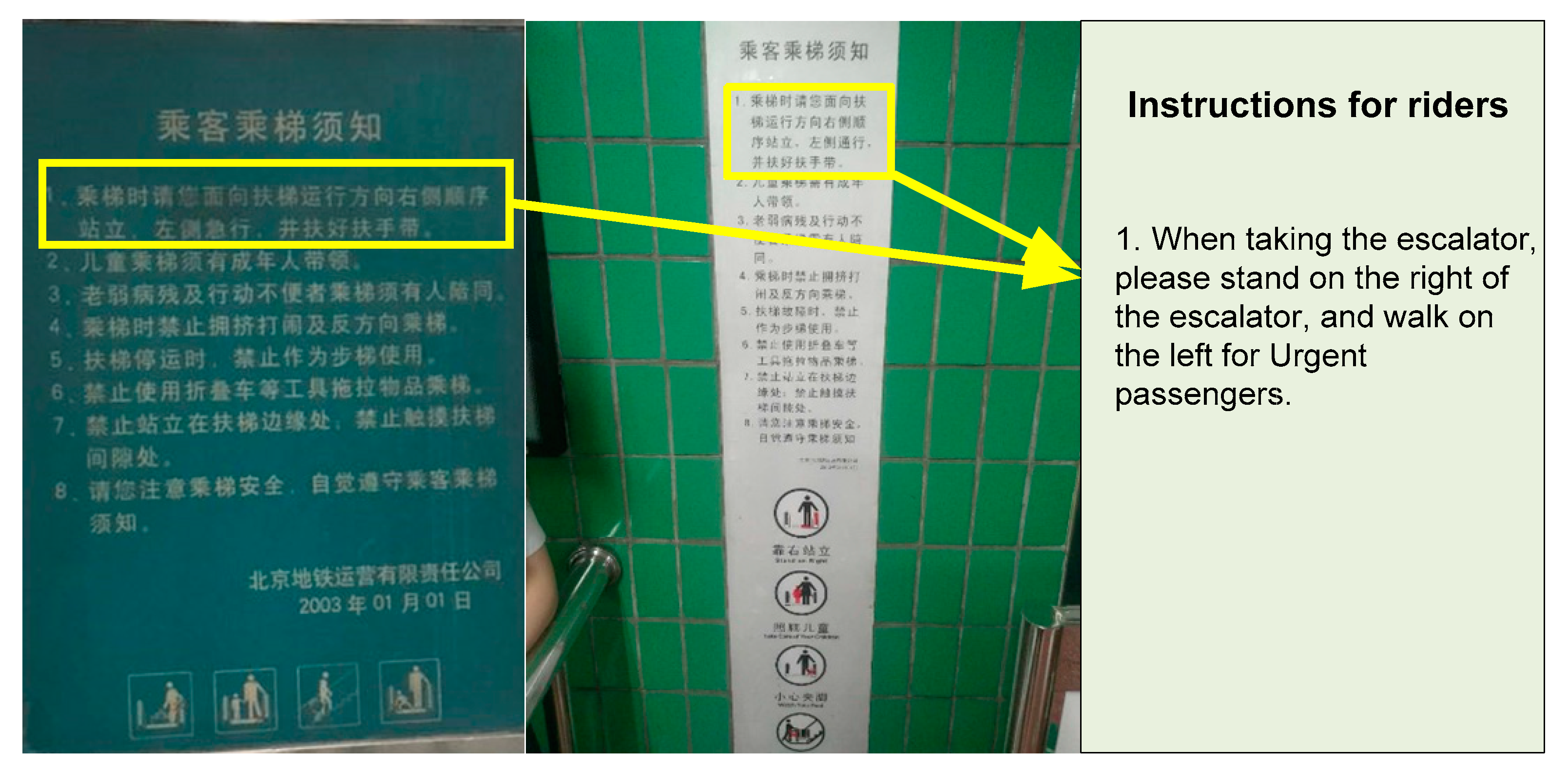
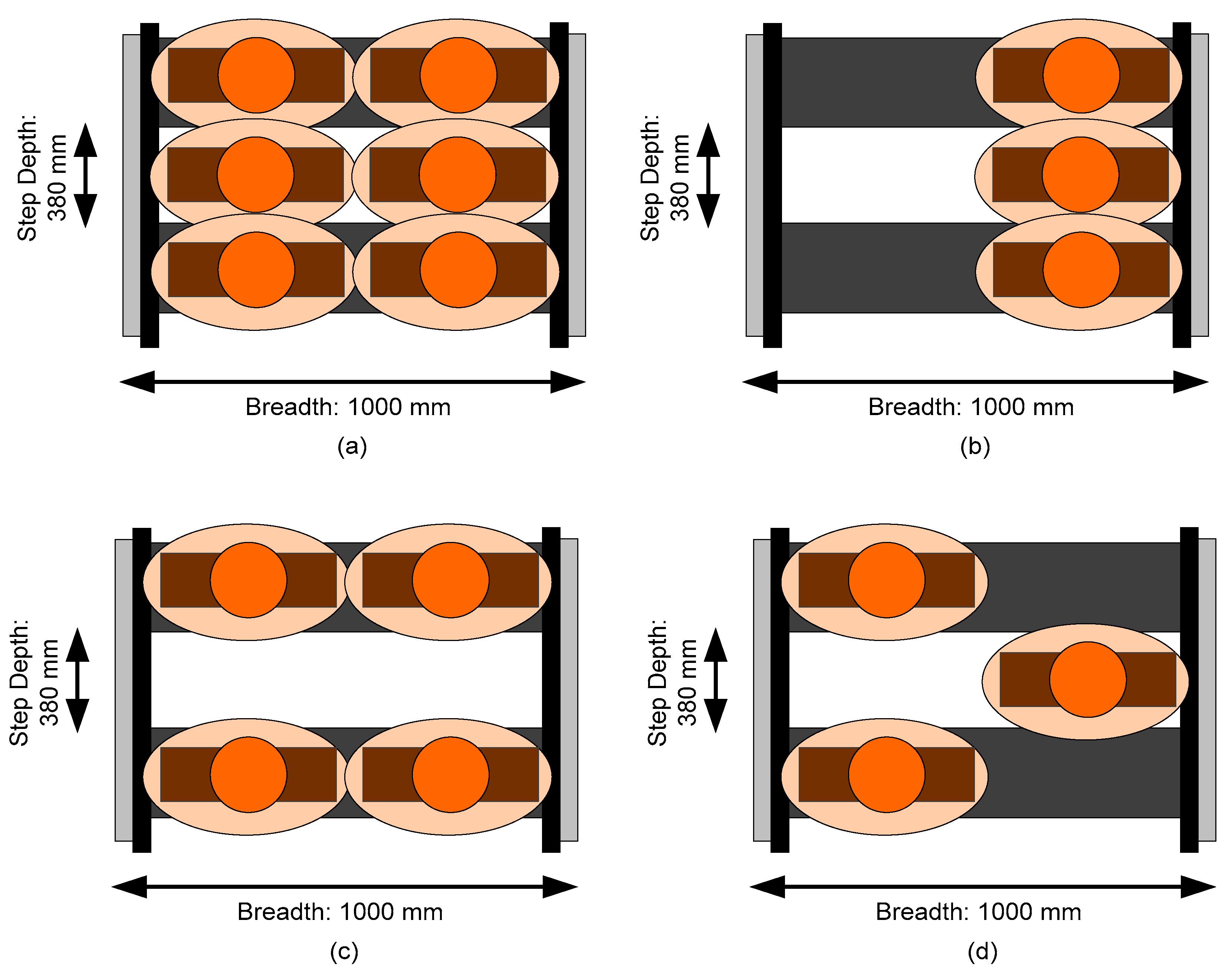
| Code Hazards Description | Code Hazards Description |
|---|---|
| Escalator | Rider (Improper riding behavior–non-task-active) |
| 1 Speed of escalator change | 30 Pick up the dropped item |
| 2 Handrail poor electrical isolation | 31 Wearing improper outfit |
| 3 Handrails are not synchronized with the escalator | 32 Drop the clothing items |
| 4 Insufficient height between escalator and the Billboard above | 33 Stepping off the escalator |
| 5 Emergency stops | 34 Step on edges of escalator steps |
| 6 Unexpected reverse | 35 Not holding the handrail |
| 7 Shake | 36 Not standing still |
| Maintenance | Rider (Bad health condition) |
| 8 Water absorbing blanket bulge | 37 Fainting/black out |
| 9 The exposure of damaged part of escalator | 38 Use of personal items on the escalator (e.g., pushchair, crutch) |
| 10 The camouflage door under the escalator opens | 39 Drunk |
| 11 Escalator floor plate bulges | 40 Old people have difficulty in moving |
| Environment | 41 Pregnancy |
| 12 Water on floor or steps | 42 Small kids unbalanced |
| 13 Object or riders falling or rolling down | 43 Lack of lower body mobility in older/unhealthy people |
| 14 Too crowded | 44 Poor eyesight |
| Rider (task-driven behavior) | 45 Disabled |
| 15 Running or walking on the escalator | 46 Bad health condition |
| 16 Concentrated on mobile phones, newspapers in hand | Rider (Last passive action) |
| 17 With children/attending to children | 47 Being struck/hit by luggage |
| 18 Taking care for fellow traveler | 48 Being knocked over by riders |
| 19 Carrying wheelchair or trolley or bicycle | 49 Crushed by riders ahead or behind |
| 20 Dropping the baby out of stroller/arm | 50 Cannot hold the handrail |
| 21 Carrying bulk items (luggage) | 51 Cannot stand still |
| 22 Dropping luggage | 52 Loss of balance |
| 23 Cannot lift the luggage | 53 Slipped over |
| 24 Playing on the escalator | 54 Tripped over |
| 25 Quarrels with others | 55 Entrapment of outfit |
| 26 Looking back | 56 Being pulled out of balance by suitcase |
| 27 Accompanying riders | 57 Being pulled out of balance by falling riders |
| 28 Help the falling riders | 58 Being Knocked over/hit by the part of escalator |
| 29 Stop luggage falling | 59 Got electrocution from escalator |
| 60 Scared | |
| 61 Sprained the ankle |
| Case No. | Hazard Chains | Case No. | Hazard Chains | Case No. | Hazard Chains |
|---|---|---|---|---|---|
| 1 | 27→36→52→13→47→57 | 110 | 36→52→13→49 | 219 | 21→35→52 |
| 2 | 27→36→52→13→47→57 | 111 | 36→52→13→49 | 220 | 21→35→52 |
| 3 | 27→36→52→13→48→57 | 112 | 40→52→28→49 | 221 | 21→35→52 |
| 4 | 27→36→52→13→49→57 | 113 | 13→21→52→49 | 222 | 21→35→52 |
| 5 | 42→52→13→17→49→57 | 114 | 21→35→52→49 | 223 | 21→35→52 |
| 6 | 21→22→56→13→49 | 115 | 21→35→52→49 | 224 | 21→35→52 |
| 7 | 17→39→36→52→49 | 116 | 21→35→52→49 | 225 | 21→35→52 |
| 8 | 21→29→23→56→52 | 117 | 21→35→52→49 | 226 | 21→35→52 |
| 9 | 37→21→22→13→28→57 | 118 | 21→35→52→49 | 227 | 21→35→52 |
| 10 | 38→35→36→13→28→57 | 119 | 17→42→52→49 | 228 | 21→35→52 |
| 11 | 21→23→52→13→28→57 | 120 | 17→36→20→52 | 229 | 21→35→52 |
| 12 | 21→29→52→13→28→57 | 121 | 38→40→21→52 | 230 | 21→35→52 |
| 13 | 17→35→52→13→28→57 | 122 | 21→25→26→52 | 231 | 21→35→52 |
| 14 | 17→35→52→13→28→57 | 123 | 40→13→28→52 | 232 | 21→35→52 |
| 15 | 21→35→52→13→28→57 | 124 | 36→52→28→52 | 233 | 21→35→52 |
| 16 | 17→35→52→13→47 | 125 | 19→35→29→52 | 234 | 21→35→52 |
| 17 | 17→40→52→13→49 | 126 | 15→25→33→52 | 235 | 21→35→52 |
| 18 | 17→42→52→13→49 | 127 | 14→21→35→52 | 236 | 21→35→52 |
| 19 | 21→23→56→13→49 | 128 | 14→21→35→52 | 237 | 21→35→52 |
| 20 | 21→23→56→13→49 | 129 | 33→21→35→52 | 238 | 21→35→52 |
| 21 | 21→23→56→13→49 | 130 | 38→21→35→52 | 240 | 21→35→52 |
| 22 | 21→23→56→13→49 | 131 | 45→21→35→52 | 241 | 21→35→52 |
| 23 | 21→29→56→13→49 | 132 | 21→23→35→52 | 242 | 21→35→52 |
| 24 | 21→29→56→13→49 | 133 | 21→23→35→52 | 243 | 21→35→52 |
| 25 | 21→29→56→13→49 | 134 | 21→23→35→52 | 244 | 21→35→52 |
| 26 | 21→22→13→17→49 | 135 | 21→23→35→52 | 245 | 21→35→52 |
| 27 | 39→37→13→17→49 | 136 | 21→23→35→52 | 246 | 21→35→52 |
| 28 | 17→40→52→20→49 | 137 | 40→27→35→52 | 247 | 21→35→52 |
| 29 | 17→40→52→20→49 | 138 | 13→28→35→52 | 248 | 21→35→52 |
| 30 | 17→40→52→20→52 | 139 | 13→28→35→52 | 249 | 21→35→52 |
| 31 | 17→42→21→23→52 | 140 | 21→29→35→52 | 250 | 21→35→52 |
| 32 | 21→29→40→23→56 | 141 | 21→40→35→52 | 251 | 21→35→52 |
| 33 | 21→29→40→23→56 | 142 | 43→17→36→52 | 252 | 21→35→52 |
| 34 | 36→52→13→28→56 | 143 | 21→35→40→52 | 253 | 21→35→52 |
| 35 | 36→52→13→28→57 | 144 | 21→35→40→52 | 254 | 21→35→52 |
| 36 | 36→52→13→28→57 | 145 | 21→35→40→52 | 255 | 21→35→52 |
| 37 | 21→35→52→28→57 | 146 | 21→35→40→52 | 256 | 21→35→52 |
| 38 | 31→32→30→35→57 | 147 | 21→35→40→52 | 257 | 21→35→52 |
| 39 | 21→22→13→47→57 | 148 | 17→40→42→52 | 258 | 21→35→52 |
| 40 | 21→22→13→47 | 149 | 14→51→50→52 | 259 | 21→35→52 |
| 41 | 21→22→13→47 | 150 | 14→51→50→52 | 260 | 21→35→52 |
| 42 | 21→22→13→47 | 151 | 14→51→50→52 | 261 | 21→35→52 |
| 43 | 21→22→13→47 | 152 | 14→51→50→52 | 262 | 21→35→52 |
| 44 | 21→22→13→47 | 153 | 14→51→50→52 | 263 | 21→35→52 |
| 45 | 21→22→13→47 | 154 | 14→51→50→52 | 264 | 21→35→52 |
| 46 | 21→22→13→47 | 155 | 14→51→50→52 | 265 | 21→35→52 |
| 47 | 21→29→13→47 | 156 | 14→51→50→52 | 266 | 21→35→52 |
| 48 | 21→29→13→47 | 157 | 21→22→13→56 | 267 | 21→35→52 |
| 49 | 21→29→13→47 | 158 | 21→29→13→56 | 268 | 21→35→52 |
| 50 | 21→29→13→47 | 159 | 21→29→13→56 | 269 | 21→35→52 |
| 51 | 35→52→13→48 | 160 | 21→29→13→56 | 270 | 24→35→52 |
| 52 | 35→52→13→48 | 161 | 21→29→13→56 | 271 | 38→35→52 |
| 53 | 36→52→13→48 | 162 | 21→40→23→56 | 272 | 40→35→52 |
| 54 | 36→52→13→48 | 163 | 21→40→29→56 | 273 | 38→36→52 |
| 55 | 36→52→13→48 | 164 | 21→23→35→56 | 274 | 40→36→52 |
| 56 | 36→52→13→48 | 165 | 21→23→35→56 | 275 | 40→36→52 |
| 57 | 36→52→13→48 | 166 | 21→29→40→56 | 276 | 40→36→52 |
| 58 | 17→40→52→48 | 167 | 21→29→40→56 | 277 | 40→36→52 |
| 59 | 21→29→13→49 | 168 | 40→36→13→57 | 278 | 40→36→52 |
| 60 | 21→29→13→49 | 169 | 40→36→13→57 | 279 | 40→36→52 |
| 61 | 19→34→13→49 | 170 | 40→36→13→57 | 280 | 40→36→52 |
| 62 | 19→34→13→49 | 171 | 36→52→13→57 | 281 | 40→36→52 |
| 63 | 17→36→13→49 | 172 | 36→52→13→57 | 282 | 40→36→52 |
| 64 | 35→36→13→49 | 173 | 36→52→28→57 | 283 | 42→36→52 |
| 65 | 40→36→13→49 | 174 | 40→52→28→57 | 284 | 43→36→52 |
| 66 | 35→52→13→49 | 175 | 40→52→28→57 | 285 | 43→36→52 |
| 67 | 35→52→13→49 | 176 | 40→52→28→57 | 286 | 16→39→52 |
| 68 | 35→52→13→49 | 177 | 40→52→28→57 | 287 | 21→40→52 |
| 69 | 35→52→13→49 | 178 | 40→52→28→57 | 288 | 38→43→52 |
| 70 | 35→52→13→49 | 179 | 40→52→28→57 | 289 | 38→43→52 |
| 71 | 35→52→13→49 | 180 | 40→27→36→57 | 290 | 1→46→52 |
| 72 | 35→52→13→49 | 181 | 1→46→61→60 | 291 | 41→53→52 |
| 73 | 35→52→13→49 | 182 | 17→52→20 | 292 | 33→53→52 |
| 74 | 35→52→13→49 | 183 | 40→35→36 | 293 | 31→55→52 |
| 75 | 35→52→13→49 | 185 | 21→13→47 | 294 | 31→55→52 |
| 76 | 36→52→13→49 | 186 | 21→13→47 | 295 | 21→61→52 |
| 77 | 36→52→13→49 | 187 | 21→13→47 | 296 | 33→61→52 |
| 78 | 36→52→13→49 | 188 | 36→52→49 | 297 | 12→8→54 |
| 79 | 36→52→13→49 | 189 | 42→17→52 | 298 | 19→13→56 |
| 80 | 36→52→13→49 | 190 | 42→17→52 | 299 | 21→23→56 |
| 81 | 36→52→13→49 | 191 | 42→17→52 | 300 | 21→23→56 |
| 82 | 36→52→13→49 | 192 | 35→21→52 | 301 | 21→23→56 |
| 83 | 36→52→13→49 | 193 | 38→21→52 | 302 | 21→23→56 |
| 84 | 36→52→13→49 | 194 | 17→24→52 | 303 | 21→23→56 |
| 85 | 36→52→13→49 | 195 | 21→29→52 | 304 | 21→23→56 |
| 86 | 36→52→13→49 | 196 | 21→29→52 | 305 | 21→23→56 |
| 87 | 36→52→13→49 | 197 | 21→29→52 | 306 | 21→23→56 |
| 88 | 36→52→13→49 | 198 | 15→33→52 | 307 | 21→23→56 |
| 89 | 36→52→13→49 | 199 | 15→33→52 | 308 | 21→23→56 |
| 90 | 36→52→13→49 | 200 | 16→33→52 | 309 | 21→23→56 |
| 91 | 36→52→13→49 | 201 | 21→33→52 | 310 | 21→23→56 |
| 92 | 36→52→13→49 | 202 | 21→35→52 | 311 | 21→23→56 |
| 93 | 36→52→13→49 | 203 | 17→35→52 | 312 | 21→23→56 |
| 94 | 36→52→13→49 | 204 | 17→35→52 | 313 | 21→23→56 |
| 95 | 36→52→13→49 | 205 | 17→35→52 | 314 | 21→29→56 |
| 96 | 36→52→13→49 | 206 | 17→35→52 | 315 | 21→29→56 |
| 97 | 36→52→13→49 | 207 | 17→35→52 | 316 | 21→29→56 |
| 98 | 36→52→13→49 | 208 | 17→35→52 | 317 | 21→29→56 |
| 99 | 36→52→13→49 | 209 | 17→35→52 | 318 | 21→29→56 |
| 100 | 36→52→13→49 | 210 | 17→35→52 | 319 | 21→29→56 |
| 101 | 36→52→13→49 | 211 | 17→35→52 | 320 | 21→29→56 |
| 102 | 36→52→13→49 | 212 | 17→35→52 | 321 | 21→29→56 |
| 103 | 36→52→13→49 | 213 | 18→35→52 | 322 | 21→29→56 |
| 104 | 36→52→13→49 | 214 | 19→35→52 | 323 | 27→35→57 |
| 105 | 36→52→13→49 | 215 | 21→35→52 | 324 | 27→35→57 |
| 106 | 36→52→13→49 | 216 | 21→35→52 | 325 | 1→41→60 |
| 107 | 36→52→13→49 | 217 | 21→35→52 | 326 | 1→46→60 |
| 108 | 36→52→13→49 | 218 | 21→35→52 | 327 | 1→46→60 |
| 109 | 36→52→13→49 | 21→35→52 | 1→46→60 |
| Rank | Hazard | Un-Weighted Clustering Coefficient | Hazard | Weighted Clustering Coefficient |
|---|---|---|---|---|
| 1 | Dropping luggage | 0.83 | Dropping luggage | 2.01 × 10−3 |
| 2 | Accompanying riders | 0.67 | Not standing still | 9.84 × 10−4 |
| 3 | Stop luggage falling | 0.57 | Cannot lift the luggage | 9.45 × 10−4 |
| 4 | Looking back | 0.50 | Accompanying riders | 7.68 × 10−4 |
| 5 | Playing on the escalator | 0.50 | Stop luggage falling | 7.32 × 10−4 |
| 6 | Cannot lift the luggage | 0.50 | Object or riders falling or rolling down | 7.01 × 10−4 |
| 7 | Use of personal items on the escalator (e.g., pushchair, crutch) | 0.50 | Help the falling riders | 6.64 × 10−4 |
| 8 | Stepping off the escalator | 0.50 | Looking back | 5.76 × 10−4 |
| 9 | Small kids unbalanced | 0.45 | Playing on the escalator | 4.39 × 10−4 |
| 10 | Being pulled out of balance by suitcase | 0.43 | Use of personal items on the escalator (e.g., pushchair, crutch) | 3.23 × 10−4 |
| Rank | Hazards | Value | Hazard Interactions | Value |
|---|---|---|---|---|
| 1 | Loss of balance | 0.1663 | Loss of balance-Object or riders falling or rolling down | 0.3798 |
| 2 | Object or riders falling or rolling down | 0.1607 | Object or riders falling or rolling down–With children/attending to children | 0.2147 |
| 3 | Carrying bulk items (luggage) | 0.1248 | Object or riders falling or rolling down Carrying bulk items (luggage) | 0.1403 |
| 4 | With children/attending to children | 0.0641 | With children/attending to children-Drunk | 0.0744 |
| 5 | Not holding the handrail | 0.0506 | Not holding the handrail-Carrying bulk items (luggage) | 0.0713 |
| 6 | Stepping off the escalator | 0.0241 | Carrying bulk items (luggage)–Quarrels with others | 0.0674 |
| 7 | Old people have difficulty in moving | 0.0219 | Carrying bulk items (luggage)–Stepping off the escalator | 0.0636 |
| 8 | Drunk | 0.0134 | Carrying bulk items (luggage)–Sprained the ankle | 0.0605 |
| 9 | Quarrels with others | 0.0128 | Pick up the dropped item–Not holding the handrail | 0.0558 |
| 10 | Pick up the dropped item | 0.0121 | Drunk-Fainting/black out | 0.0512 |
© 2020 by the authors. Licensee MDPI, Basel, Switzerland. This article is an open access article distributed under the terms and conditions of the Creative Commons Attribution (CC BY) license (http://creativecommons.org/licenses/by/4.0/).
Share and Cite
Wang, Z.; Bhamra, R.S.; Wang, M.; Xie, H.; Yang, L. Critical Hazards Identification and Prevention of Cascading Escalator Accidents at Metro Rail Transit Stations. Int. J. Environ. Res. Public Health 2020, 17, 3400. https://doi.org/10.3390/ijerph17103400
Wang Z, Bhamra RS, Wang M, Xie H, Yang L. Critical Hazards Identification and Prevention of Cascading Escalator Accidents at Metro Rail Transit Stations. International Journal of Environmental Research and Public Health. 2020; 17(10):3400. https://doi.org/10.3390/ijerph17103400
Chicago/Turabian StyleWang, Zhiru, Ran S. Bhamra, Min Wang, Han Xie, and Lili Yang. 2020. "Critical Hazards Identification and Prevention of Cascading Escalator Accidents at Metro Rail Transit Stations" International Journal of Environmental Research and Public Health 17, no. 10: 3400. https://doi.org/10.3390/ijerph17103400
APA StyleWang, Z., Bhamra, R. S., Wang, M., Xie, H., & Yang, L. (2020). Critical Hazards Identification and Prevention of Cascading Escalator Accidents at Metro Rail Transit Stations. International Journal of Environmental Research and Public Health, 17(10), 3400. https://doi.org/10.3390/ijerph17103400





